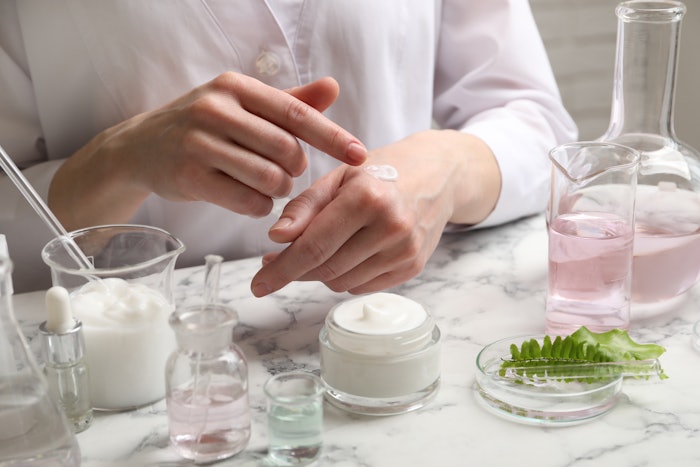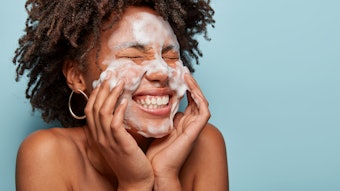
On May 4, 2023, the China National Institutes for Food and Drug Control (NIFDC) released the draft “Technical Guidelines for Filling in and Submitting Cosmetic Formulas” for public consultation.1
Log in to view the full article
China: Cosmetic Formula Information Submission
On May 4, 2023, the China National Institutes for Food and Drug Control (NIFDC) released the draft “Technical Guidelines for Filling in and Submitting Cosmetic Formulas” for public consultation.1
The guidelines provide instructions for enterprises seeking to register or notify special and general cosmetics, outlining the requirements for completing the cosmetic formula table. These include:
- Judging whether ingredients or ingredient components are considered part of the formula;
- Requirements for filling in single-component ingredients, compounds and group ingredients;
- Requirements for filling in the ingredient name, concentration, ingredient use purpose and safety information;
- Requirements for filling in the “remarks” column in the formula table and the “remarks” column below the formula table; and
- Other requirements; i.e., the safety of ingredients or ingredient components that are not considered part of the formula that should also be explained and fully assessed in the safety assessment report.
The guidelines aim to offer technical guidance for cosmetic companies. They also introduce additional requirements – particularly for ingredients and ingredient components not considered part of the formula – that will present challenges for product safety assessment in the future.
China: Ingredient Safety Information
Also on May 4, 2023, the NIFDC initiated a public consultation on the “Technical Guidelines for Filling in and Submitting Safety Information of Cosmetic Ingredients.”2
The guidelines outline vital points and technical principles for completing and submitting ingredient safety information. They cover aspects such as basic ingredient information, brief descriptions of ingredient production techniques, necessary quality control requirements, limit requirements for risk substances, etc.
Primary highlights are:
- The guidelines are applicable to situations where cosmetic registrants or notifiers complete and submit ingredient safety information in cosmetic registration or notification documents on their own; they are not applicable to cases where ingredient manufacturers submit ingredient safety information through the cosmetic ingredients safety information submission platform.
- The ingredient composition must be consistent in the ingredient safety information of the same type of ingredients completed by the same cosmetic registrant or notifier. Due to differences in technical understandings, cosmetic registrants and notifiers may have differences in the filling of trace components added non-subjectively. These differences shall not affect the quality and safety evaluation of cosmetics and shall be able to be reasonably explained.
China: Ingredient Safety Information Platform
On May 12, 2023, the NIFDC opened a public commenting period on the “Guidelines for Submitting Information Through the Cosmetic Ingredient Safety Information Submission Platform.”3 This draft provides guidance for ingredient manufacturers on the correct use of the ingredient safety information submission platform to standardize submissions.
The guidelines clarify that the platform is exclusively applicable to the submission of safety information for ingredients that are listed in the “Inventory of Existing Cosmetic Ingredients in China 2021” (IECIC) with independent serial numbers. Ingredient manufacturers must submit safety information in accordance with relevant regulations and technical specifications and be responsible for the authenticity and completeness of the information. They can submit the safety information themselves or authorize Chinese domestic or foreign legal entities to submit and maintain it. However, for ingredients with the same quality specification, only one enterprise can be authorized to submit the safety information.
The guidelines also provide a document template of ingredient safety information. Compared with the previous version implemented on Dec. 31, 2021, the new template has removed content related to: the production method of physical mixing, the reason for compounding/mixing of ingredients and the content of ingredient components. Additionally, changes have been made to the filling positions of necessary solvents, stabilizers, preservatives and antioxidants added in the production process. These changes suggest that the guidelines may only apply to the submission of safety information for a single ingredient.
China: New Cosmetic Ingredients
On June 5, 2023, the China NIFDC released nine guidelines pertaining to the registration of Chinese domestic and imported special cosmetics, as well as high-risk new cosmetic ingredients (NCIs).4 These include guidelines for the approval of:
- Registrations for new cosmetic ingredients with high risks;
- Registration changes for Chinese domestic special cosmetics;
- Initial registrations for Chinese domestic special cosmetics;
- Registration renewals for Chinese domestic special cosmetics;
- Registration cancellations for Chinese domestic special cosmetics (cancellation upon application);
- Registration changes for imported special cosmetics;
- Initial registrations for imported special cosmetics;
- Registration renewals for imported special cosmetics; and
- Registration cancellations for imported special cosmetics (cancellation upon application).
These guidelines provide details and time limits for first registration, registration change, registration renewal and registration cancellation applications.
China: New Approved Cosmetic Ingredients
Also in May 2023, the National Medical Products Administration (NMPA) updated the notification status of nine new cosmetic ingredients (NCIs). Basic information about these new NCIs is as follows:
- Gynura procumbens extract, notified on May 5, 2023;
- Hydroxymethoxyphenyl decanone (CAS No. 27113-22-0), notified on May 5, 2023;
- Hexyl/succinyl dimethicone crosspolymer (CAS No. 2486020-17-9), notified on May 10, 2023;
- Acetyl carnosine (CAS No. 56353-15-2), notified on May 16, 2023;
- Mesembryanthemum crystallinum callus extract, notified on May 16, 2023;
- Fuscoporia obliqua/Betula alba juice ferment, notified on May 17, 2023;
- Tocopheryl retinoate (CAS No. 40516-49-2), notified on May 18, 2023;
- TEA-acrylate/TEA-acryloyldimethyl taurate copolymer, notified on May 22, 2023; and
- Ilex latifolia leaf extract, notified on May 30, 2023.
South Korea: Cosmetic Safety Standards
The Ministry of Food and Drug Safety (MFDS) unveiled the draft “Regulation on Safety Standards, etc., for Cosmetics” for public comment on May 4, 2023.5 Following risk assessment results, the authority proposed to designate seven restricted ingredients as new prohibited ingredients.
The seven ingredients proposed are:
- Nitro-p-phenylenediamine;
- 2-Amino-4-nitrophenol;
- 2-Amino-5-nitrophenol;
- 2-Amino-5-nitrophenol sulfate;
- o-Aminophenol sulfate;
- o-chloro-p-Phenylenediamine sulfate; and
- m-Phenylenediamine sulfate.
These ingredients are hair dyes. Once the draft passed and the regulation came into effect, enterprises were prohibited from manufacturing hair dye products using these ingredients. MFDS also provided a grace period of two years for enterprises to sell products that had been manufactured or imported before the implementation of the regulation.
Thailand: Ampoule, Vial and Syringe Cosmetics
In May 2023, the Thai Food and Drug Administration (Thai FDA) introduced revised criteria for reviewing notifications of ampoule, vial and syringe cosmetics. The new standard aims to safeguard the safety and quality of such cosmetics, prevent their misuse and abuse, and provide guidance for businesses.6
Highlights include:
- Cosmetics packaged in ampoules, vials or syringes should neither be classified as drugs, nor be used in conjunction with medical devices or intended for use after a medical procedure such as laser treatment or microneedle therapy system (MTS).
- Enterprises are required to provide the certification from manufacturers, product samples, statements from the manufacturer or importer, clear and visible images of the actual product for sale and its labels, tubes, boxes, bottles and inserts for review when filing a notification.
- In cases where the product name of an ampoule, vial or syringe cosmetic is the same as a product used for injection or used with medical devices in foreign countries, the manufacturer must modify the product name, label design or label color to avoid consumer confusion. The label must also bear a warning such as: "Do not inject or use in conjunction with medical devices,” or “For external use only," or a similar message.
India: Cosmetics Rules 2020
On May 17, 2023, the Ministry of Health and Family Welfare of India initiated a public consultation on proposed amendments to “Cosmetics Rules 2020,” with the goal of improving the regulation and quality control of cosmetics in India.7
Key points of the amendments are:
- Further clarifying and explaining the terms "use before" and "date of expiry.” Here, “use before" means “using the cosmetic product before the first day of the month specified on the label,” whereas "date of expiry" refers to the last day of the month mentioned.
- The labeling requirements for cosmetics intended for export were streamlined. Existing provisions that necessitate the inclusion of certain particulars on both the innermost packaging and every outer covering of cosmetics will be removed. Instead, labels on the packaging or container of exported cosmetics solely will be subject to the legal requirements of the destination country.
- State licensing authorities were empowered to cancel or suspend licenses of cosmetics for sale or distribution in cases where the licensee has failed to comply with the license conditions, provisions of the “Drugs and Cosmetics Act, 1940,” or related rules.
Philippines: LTO Application
On June 5, 2023, the Philippines Food and Drug Administration (FDA) released a new draft of “Updated Guidelines on the Application for License to Operate of Health Product Establishments with the Food and Drug Administration.”8
In the Philippines, companies that manufacture, import, distribute or sell cosmetic products are required to obtain a License to Operate (LTO) from the FDA. In 2020, Administrative Order (AO) No. 2020-0017 was issued to introduce the required documents and procedures for applying for LTO. To further streamline the processes for initial, renewal and variation applications for LTO, the FDA initiated consultations on amendments to AO No. 2020-0017 in May and October of last year (2022).
Compared with the previous two drafts, this draft proposes the following adjustments relating to cosmetics:
- Introducing stricter guidelines for initial, renewal and variation applications for the LTO;
- Detailing the circumstances under which the LTO may be cancelled; and
- Strengthening the requirements for the qualified person.
Conclusion
In summary, detailed guidelines have been issued by China for the submission of different types of information, such as ingredient safety information and cosmetic formulations. These are commonly found to be areas where companies make errors. Hence, it is crucial for relevant companies to be vigilant and verify the accuracy of the information provided.
In addition, although there have been multiple proposed revisions to India's “Cosmetic Rules 2020,” these modifications are not particularly substantial. They mostly involve: terms such as "use before" and "date of expiry; rules on license cancellation and suspension; options for record retention; the labeling requirements for exported cosmetics; and the conditions for obtaining a license, etc.
References
- ChemLinked. (2023, May 4). Technical guidelines for filling in and submitting cosmetic formula (draft for comments). Available at https://cosmetic.chemlinked.com/database/view/1510
- ChemLinked. (2023, May 4). Technical guidelines for filling in and submitting safety information of cosmetic ingredients (draft for comments). Available at https://cosmetic.chemlinked.com/database/view/1509
- ChemLinked. (2023, May 12). Guidelines for submitting information on the cosmetic ingredient safety information submission platform (draft for comments). Available at https://cosmetic.chemlinked.com/database/view/1511
- China National Institutes for Food and Drug Control. (2023, Jun 5). Nine guidelines on matters related to the registration of special cosmetics and new cosmetic ingredients. Available at https://www.nifdc.org.cn/nifdc/bshff/hzhpjssp/hzpsptzgg/20230605085903618527.html
- Ministry of Food and Drug Safety. (Accessed 2023, Aug 15). Draft of regulation on safety standards, etc. for cosmetics. Available at https://www.mfds.go.kr/brd/m_209/view.do?seq=43780&srchFr=&srchTo=&srchWord=&srchTp=&itm_seq_1=0&itm_seq_2=0&multi_itm_seq=0&company_cd=&company_nm=&page=1
- Thai Food and Drug Administration. (May 2023). Criteria for considering the notification of cosmetics in the form of ampoule, vial and syringe. Available at https://www.fda.moph.go.th/sites/Cosmetic/Shared%20Documents/Pre-marketing/AMP%20VIAL%20SYRINGE.pdf
- Ministry of Health and Family Welfare. (Accessed 2023, Aug 15). Amendments of cosmetics rules 2020. Available at: https://egazette.nic.in/WriteReadData/2023/245904.pdf
- Philippines Food and Drug Administration. (Accessed 2023, Aug 15). Updated guidelines on the application for license to operate. Available at: https://www.fda.gov.ph/draft-for-comments-updated-guidelines-on-the-application-for-license-to-operate-of-health-product-establishments-with-the-food-and-drug-administration/










